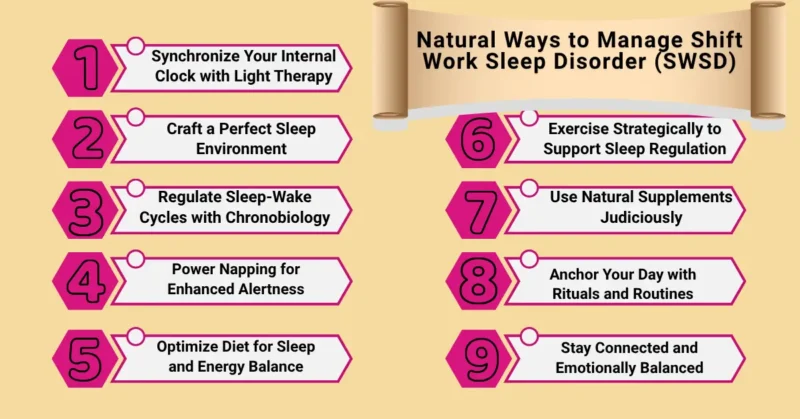Struggling with shift work sleep disorder? Discover natural, effective ways to reset your sleep cycle, boost energy, and reclaim restful nights—without medication.
Thank you for reading this post, don't forget to subscribe!Shift Work Sleep Disorder (SWSD) affects millions of individuals working non-traditional hours. It may have serious effects on both physical and mental health. We present a comprehensive, evidence-based guide to managing SWSD naturally, without dependence on medication. Healthcare professionals, night shift workers, and rotating shift employees will find this guide beneficial.
Understanding Shift Work Sleep Disorder (SWSD)
Insomnia and excessive sleepiness are the primary symptoms of SWSD, a circadian rhythm sleep disorder characterized by excessive daytime sleepiness. It results from a misalignment between internal biological clocks and external work schedules.
Common Symptoms
- Difficulty falling or staying asleep
- Poor concentration and alertness
- Irritability and mood swings
- Increased risk of workplace accidents
Long-Term Consequences of Untreated SWSD
Prolonged SWSD can lead to:
- Cardiovascular issues
- Metabolic syndrome
- Depression and anxiety
- Poor immune response
Natural Ways to Manage SWSD
Naturally, managing shift work sleep disorder (SWSD) requires a multifaceted strategy that addresses your surroundings, diet, lifestyle choices, and internal clock. Natural methods, as opposed to pharmacological ones, seek to safely and sustainably restore the body’s circadian rhythm. The following are comprehensive and useful methods that have been shown to enhance alertness, improve sleep quality, and support the overall well-being of shift workers.

1. Synchronize Your Internal Clock with Light Therapy
The most potent environmental cue affecting our circadian rhythm is light. Your body’s internal clock can be reset with controlled light exposure at the appropriate times.
- Before your shift: Use a 10,000 lux light box for 20–30 minutes to reduce melatonin and increase alertness. It works best when used 1–2 hours before starting a night shift.
- During your shift, keep your workspace well-lit with bright, white, or blue-enhanced lighting to stay focused and alert.
- After your shift, wear amber or blue-light-blocking glasses when leaving work in daylight. It helps your body recognize when it’s time to relax and prepare for sleep.
Consistent light management helps your brain adapt more smoothly to unconventional sleep schedules.
2. Craft a Perfect Sleep Environment
Environmental factors significantly affect sleep depth and continuity. Creating an optimal sleep sanctuary is essential.
- Use blackout curtains or sleep masks to block sunlight and enhance melatonin production.
- Keep your room at a chilly temperature of 60–67°F (15–19°C) to simulate nighttime and signal to your body that it’s time to sleep.
- Eliminate noise pollution using white noise machines, earplugs, or calming nature sounds.
- Keep electronics out of the bedroom to prevent electromagnetic stimulation and distractions.
The goal is to create a nighttime setting, regardless of the time you go to bed.
3. Regulate Sleep-Wake Cycles with Chronobiology
Chronotherapy is a natural technique that gradually adjusts your sleep schedule to align with your work hours. By adjusting sleep and wake times in 15–30 minute increments over several days, your circadian rhythm can realign with your shift pattern. This approach is most effective for rotating or transitioning schedules.
- Even on days off, maintain regular sleep and wake hours.
- Incorporate morning or evening rituals to signal to the brain that it’s time to sleep or stay awake (e.g., tea, a warm bath, or breathing exercises).
4. Power Napping for Enhanced Alertness
Strategic napping is a scientifically supported method for combating fatigue and restoring alertness during or before shifts.
- Pre-shift nap (90 minutes or 20 minutes): Increases alertness and performance.
- Mid-shift nap (if allowed): A short 15–20 minute nap during breaks can boost memory and reduce reaction time.
- Avoid napping close to bedtime, as it may delay your sleep onset.
Power naps are more effective when combined with caffeine immediately before napping (the “caffeine nap”), which enhances wakefulness after the nap.
5. Optimize Diet for Sleep and Energy Balance
What and when you eat influences your ability to stay awake or fall asleep.
- Before your shift: Eat a balanced meal with lean proteins, healthy fats, and complex carbs.
- During your shift: Choose light, frequent meals or snacks (e.g., yogurt, almonds, boiled eggs) to avoid energy crashes.
- After your shift, avoid heavy or sugary foods and opt for foods that boost melatonin, such as cherries, bananas, or oats.
Hydration is crucial—dehydration increases fatigue. However, reduce your fluid intake close to bedtime to prevent waking up during the night.
6. Exercise Strategically to Support Sleep Regulation
Physical activity can naturally reset your body clock and improve sleep quality if done at the right time.
- The best times for exercise are before your shift or early in the morning.
- Avoid heavy workouts within 2–3 hours of bedtime as they can delay sleep.
- Include stretching or light yoga as part of your wind-down routine to promote relaxation and ease muscle tension.
Regular movement also combats the sedentary nature of many shift jobs, reducing the risk of obesity and metabolic issues.
7. Use Natural Supplements Judiciously
Certain natural supplements can help ease the transition into sleep without habit-forming risks.
- Melatonin (0.5–3 mg): Helps initiate sleep when taken 30–60 minutes before rest time.
- Valerian root: It shortens the time it takes to fall asleep and soothes the nervous system.
- Magnesium: Supports deep sleep by regulating neurotransmitters.
- L-theanine is present in green tea and helps people relax without causing drowsiness.
- Glycine: An amino acid that improves sleep latency and sleep quality at doses of 3 grams before bed.
Always start with the lowest effective dose and avoid mixing supplements without consulting a healthcare professional.
8. Anchor Your Day with Rituals and Routines
Routines create a psychological signal for your body to prepare for certain activities, especially sleep.
- Before sleep, create a calming ritual, such as sipping herbal tea, reading, practicing deep breathing, or meditating.
- After waking: Use bright light, move your body, and eat a light, energizing meal.
- Anchor sleep schedule: Maintain at least 4 core hours of consistent sleep time daily (e.g., 3 a.m.–7 a.m.), even on days off.
A consistent routine promotes predictability, which in turn reduces anxiety and enhances sleep efficiency.
9. Stay Connected and Emotionally Balanced
Social isolation is common among shift workers and can exacerbate symptoms of shift work sleep disorder (SWSD).
- Schedule regular family or friend time around your most alert hours.
- Join online communities or forums for shift workers to share strategies and support.
- Consider talking to a sleep specialist or therapist if emotional distress or chronic insomnia continues.
Strong social support plays a key role in long-term adaptation and emotional resilience.
Lifestyle Adjustments That Support Better Sleep

- Limit screen time before bed.
- Avoid alcohol as a sleep aid—it disrupts REM cycles.
- Track your sleep quality and quantity by keeping a sleep journal.
Social and Psychological Support
Isolation is common in shift workers. Foster social connections:
- Join shift worker support groups.
- Schedule “anchor sleep” overlapping with family time.
- Seek counseling if your mood or motivation suffers.
Recommended Natural Sleep Hygiene Routine
- Pre-shift (1–2 hours before work)
- Light exposure
- Short walk or exercise
- High-protein meal
- During shift
- Hydration
- Bright, blue-enriched lighting
- Caffeine (early in shift only)
- Post-shift
- Blue-light blocking glasses
- Light breakfast
- Wind-down routine (shower, stretch)
- Sleep period
- Cool, dark room
- No electronic devices
- An optional melatonin supplement
Prevention: How Employers Can Help
Organizations can:
- Rotate shifts clockwise (morning → evening → night)
- Limit consecutive night shifts
- Provide nap areas and educate workers on sleep hygiene
- Encourage regular medical check-ups for shift workers
FAQs on Managing SWSD Naturally
Q. What is the cause of shift work disorder?
The reason for shift work sleep disorder (SWSD) is a mismatch between an individual’s external work schedule and their internal circadian rhythm. Our body’s natural clock is set up for activity during the day and sleep at night. This pattern is broken for those who work rotational or night shifts.
The body struggles to adjust, leading to poor sleep quality and excessive daytime sleepiness. Social routines and daylight are two examples of environmental cues that make adaptation even more difficult. This imbalance eventually impacts not only sleep but also general physical and mental health. Chronic sleep debt and health problems result from persistent disturbance without recovery.
Q. What are the psychological effects of working the night shift?
Night shift work can significantly affect one’s mental health. Increased stress, anger, and mood fluctuations brought on by poor sleep quality are common psychological impacts. Higher levels of anxiety and despair are frequently reported by shift workers. Loneliness and a disrupted social life are two things that contribute to emotional distress.
Memory, judgment, and focus are examples of cognitive abilities that may deteriorate. Long-term exposure may also weaken emotional regulation and resilience. Without intervention, the psychological strain can diminish the quality of life and workplace performance.
Q. Is there a good sleep aid for shift workers?
The best natural sleep aid for shift workers is low-dose melatonin (0.5–3 mg) taken 30–60 minutes before desired sleep. Melatonin helps regulate the body’s internal clock, promoting faster sleep onset and better sleep quality. Other effective natural aids include magnesium (for muscle relaxation), valerian root (for calming the nervous system), and L-theanine (for mental relaxation).
Combining these with a dark, quiet sleep environment enhances effectiveness. Avoid dependency on over-the-counter sedatives, as they may impair cognitive function. Before taking supplements, consult a healthcare professional for guidance and to ensure the safety of any medications you may be taking.
Q. Is working a night shift unhealthy?
Working night shifts over a long period can be unhealthy if not properly managed. Chronic problems like obesity, type 2 diabetes, cardiovascular disease, and gastrointestinal issues are all made more likely by it. Circadian misalignment leads to chronic sleep deprivation, which weakens the immune system and cognitive performance.
Mental health conditions like depression and anxiety are more prevalent. Poor eating habits and inactivity are common side effects of working nights. However, sleep hygiene, nutritional support, and light therapy can help mitigate many of the negative effects. The key to preserving health is awareness and preventative care.
Final Thoughts
Managing Shift Work Sleep Disorder (SWSD) naturally requires awareness, discipline, and a proactive lifestyle. While working irregular hours challenges the body’s biological clock, it doesn’t mean one must suffer endlessly from poor sleep and its consequences. Shift workers can significantly enhance their sleep quality and overall performance by adopting evidence-based practices, including maintaining regular sleep schedules, minimizing exposure to light, incorporating strategic napping, and adopting a healthy diet. Natural substances that promote sleep without the negative effects of prescription medications include melatonin, magnesium, and valerian. But consistency is essential.
Equally important is creating a supportive environment. Employers must understand the demands of shift work and promote policies that prioritize sleep health, such as rotating shifts forward, allowing strategic breaks, and fostering a culture that values recovery time. Social connection also plays a vital role. Encouraging family understanding and maintaining relationships can combat isolation and emotional fatigue.
Working the night shift or rotating shifts doesn’t have to be harmful. With conscious effort and natural interventions, it’s entirely possible to align your lifestyle with your body’s needs. You deserve restful sleep, peak alertness, and lasting well-being—no matter when you work.
Read more Life-Balance Tips.
You might like:

